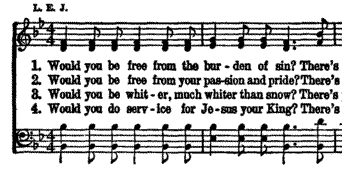Applying The O/C
The general idea of how to apply the O/C to music does not change, whether playing from a hymnal, fake book, or by ear. In the earlier lessons, we simply played the melody with our right hand and the O/C in our left. We will follow these same principles to play hymns. The only differences are that we will be playing two notes with our right hand instead of one, and the chords are not marked for us.
 First Two Measures - Hymnal Version First Two Measures - O/C Version |
The first two measures of There Is Power In The Blood (as it would appear in a hymnal) is shown to the right. Below it is the O/C version of these same measures. Immediately you should notice that we have not changed the right hand at all. In the future we will make changes, but for now, our focus will be on playing the correct chord with the left hand.
Since hymnals were written for singers, not instrumentalists, rarely will chord symbols be printed in the music. This one fact frightens many pianists. They often resort to only playing from "their" book, in which they have already written the chord names above each measure, and they will often avoid playing unfamiliar songs. All of this can be avoided if one will learn a few simple guidelines to help determine which chord should be played.
First, look at the bass (lowest) note. Most of the time the Bass note will tell you the name of the chord. In this first measure, the Bass note is a Bb. To know for sure whether or not the chord is also Bb, compare the Tenor, Alto, and Soprano notes with the other notes of a Bb chord. In this case, the Tenor note is Bb, the Alto note is D, and the Soprano note is F. These three notes, Bb (in the Bass and Tenor), D, and F make up the Bb chord. Therefore, we know that we should use a Bb O/C until the notes change.
The notes do not change through the rest of the first measure, so we know that the chord will not change, either. The second measure is different, though. We have a new set of notes to look at. They are, beginning with the bass, Eb, Bb, Eb and G. Since the bass note is an Eb, the chord will probably be an Eb, too, but we need to double check this. The notes given are Eb, Bb, and G (ignoring the doubled notes). The tones that make up an Eb chord are Eb, G, and Bb. Since the notes in the music match what we recognize as an Eb chord, then the Eb O/C must be what we should play! (The order in which the notes are "stacked up" does not matter, and will not change the name of the chord. For example, even if the notes appeared in the order G, Bb, Eb, they would still be understood to be an Eb chord. We will talk about this more later.)
The notes change again on the third beat of the second measure. The bass goes back to a Bb, and the remaining notes are Bb, D, and F. The bass note gives us the clue that this might be a Bb chord, and the remaining notes, Bb, D, and F, confirm it. One could also look at the fact that these notes are the same as appear in the first measure, and therefore must be the same chord as the first measure.
